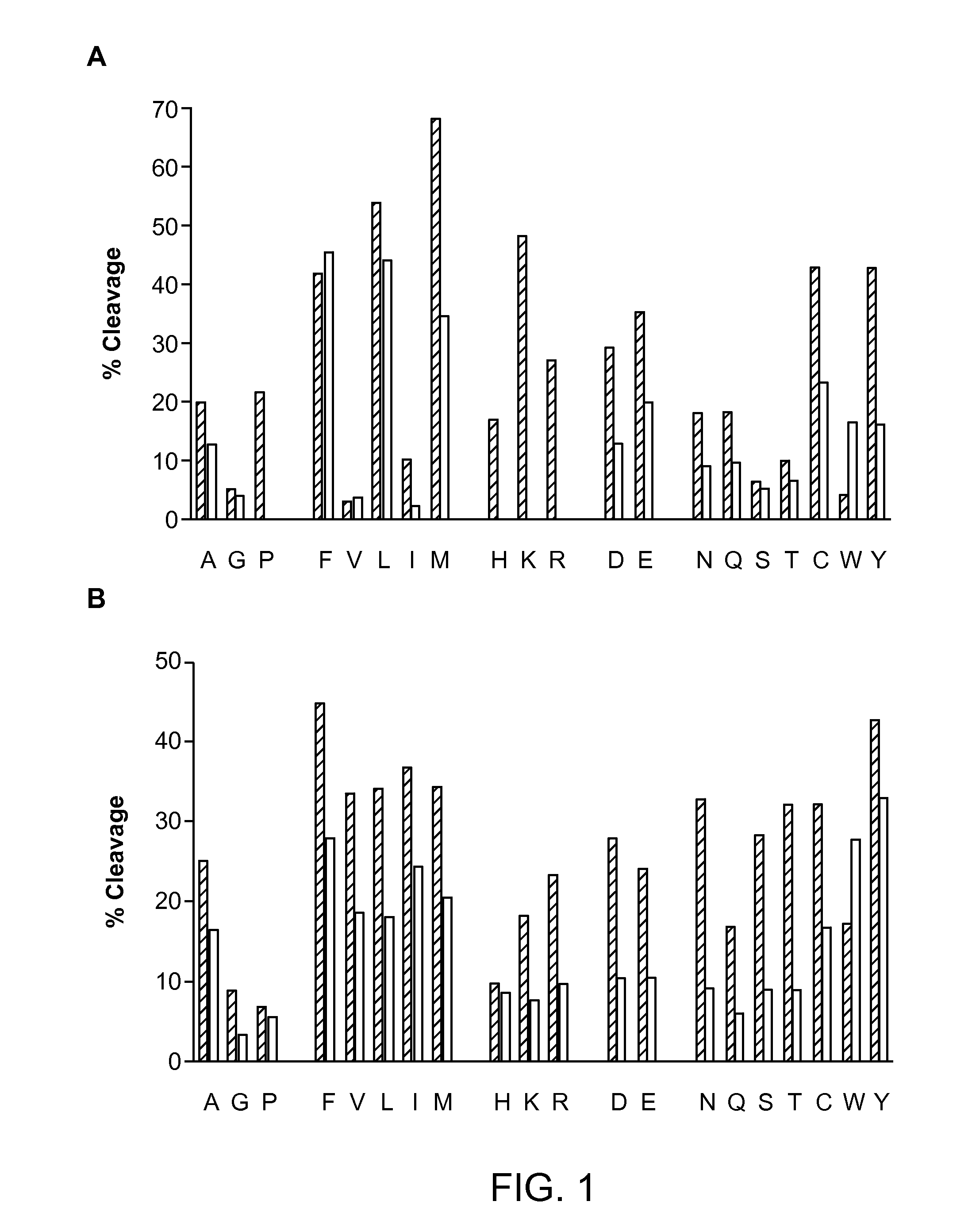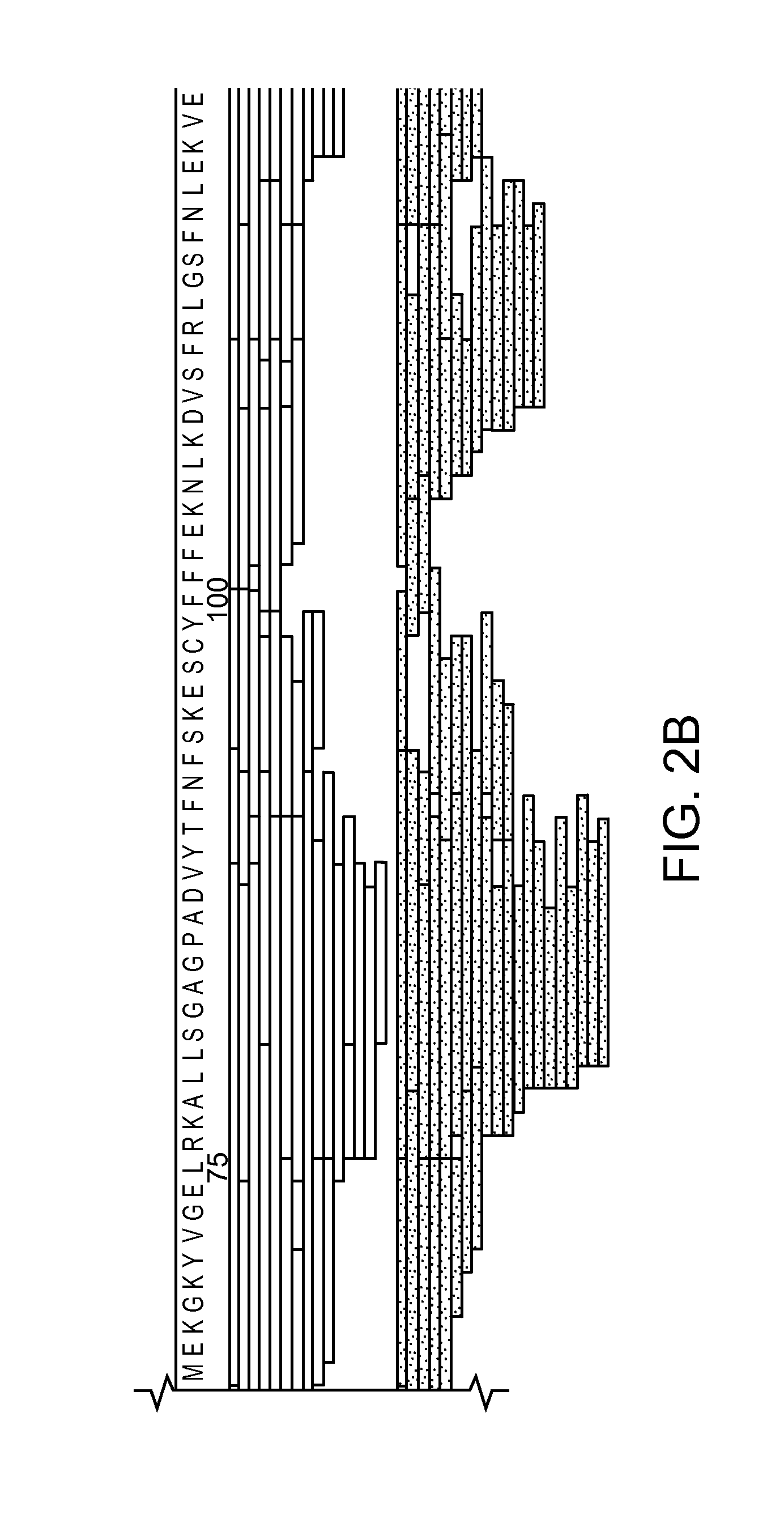Treatment of gluten intolerance and related conditions
a technology for gluten intolerance and related conditions, applied in the direction of immunological disorders, peptide/protein ingredients, antibacterial agents, etc., can solve the problems of gluten being difficult to avoid, gluten being difficult to eat gluten, inconvenient gluten-free diet, etc., to achieve different cleavage affinity, reduce the level of toxic gluten proteins, and increase the affinity
- Summary
- Abstract
- Description
- Claims
- Application Information
AI Technical Summary
Benefits of technology
Problems solved by technology
Method used
Image
Examples
example 1
Nepenthesin Extract Preparation
Chemicals
[0152]Water and acetonitrile, HPLC grade form Burdick and Jackson, were purchased from VWR. Formic acid, Tris, glycine were purchased from Sigma Aldrich.
Plant Culture
[0153]Transplants of Nepenthes rafflesiana, Nepenthes ampularia, Nepenthes mirabilis, and Nepenthes globosa were purchased from Keehns Carnivores (http: / / www.keehnscarnivores.ca). These were potted with wood bark, perlite, peat moss and humus (40, 35, 10, 5% respectively). Growth conditions involved 14 hours of light per day, 80% humidity and temperature in the 23-28° C. range with 2 to 3 waterings a week. Upon pitcher maturity, plants were fed with one or two Drosophila per pitcher and the pitcher fluid harvested one week later. Pitchers and their secretions were left to recover for one week prior to a second round of feeding and extraction.
Extract Preparation
[0154]Pitcher fluid was collected from all four species of plants and combined. The crude pitcher fluid was first clarifie...
example 2
Digest Mapping of Proteins by Pepsin and Nepenthesin Extract
Nepenthesin Digest Mapping by Mass Spectrometry
[0156]Nepenthesin extract was prepared as in Example 1.
[0157]Digestions of proteins were carried out in solution using a LEAP HTX-PAL autosampler and dispensing system designed for hydrogen / deuterium exchange (HDX) applications, and data were collected with an AB Sciex Triple-TOF 5600 QqTOF mass spectrometer. Peptides were identified using Mascot (v2.3) from MS / MS data. Briefly, 84 of 8 μM protein (XRCC4, XLF, Ligase IV-tandem BRCT domains, PNK, myoglobin, or cytochrome C) were mixed with 10 μL of 11× concentrated fluid for 2 min. at 10° C. Myoglobin and cytochrome C were purchased from Sigma. After dilution to 1 μM substrate concentration, 15 μL were injected into the chilled reversed-phase LC system (4° C.) connected to the mass spectrometer. The peptides were trapped on a 5 cm, 200 μm i.d. Onyx C18 monolithic column (Phenomenex Inc.) and eluted with an acetonitrile gradient ...
example 3
Digest Mapping of Multi-Domain Protein, XRCC4, by Pepsin and Nepenthesin Extract
HD Exchange of a Complex Involved in DNA-Damage Repair
[0160]Nepenthesin extract was prepared as in Example 1.
[0161]Stock solutions of XRCC4 (1-200) with BRCT, and XRCC4 (full length) with BRCT were diluted in buffer (10 mM Tris-HCl, pH 7.5) to equimolar concentrations (10 μM) and incubated at 4° C. for a minimum of 30 min to promote complexation. The samples were held at 4° C. until HDX analysis. Aliquots were deuterated for 2 min at 20° C. with the addition of D2O (25% v / v). Aliquots were then digested in two ways. In the first digestion strategy, protein deuteration was quenched by adding the sample to chilled 100 mM glycine-HCl (pH 2.5), and the quenched protein solution was injected into a pepsin microreactor. This microreactor was installed in the HTX-PAL system between the injector valve and the C18 column. Protein digest was captured on the monolithic C18 capillary column and eluted into the mass ...
PUM
| Property | Measurement | Unit |
|---|---|---|
| temperature | aaaaa | aaaaa |
| humidity | aaaaa | aaaaa |
| molecular weight | aaaaa | aaaaa |
Abstract
Description
Claims
Application Information
 Login to View More
Login to View More - R&D
- Intellectual Property
- Life Sciences
- Materials
- Tech Scout
- Unparalleled Data Quality
- Higher Quality Content
- 60% Fewer Hallucinations
Browse by: Latest US Patents, China's latest patents, Technical Efficacy Thesaurus, Application Domain, Technology Topic, Popular Technical Reports.
© 2025 PatSnap. All rights reserved.Legal|Privacy policy|Modern Slavery Act Transparency Statement|Sitemap|About US| Contact US: help@patsnap.com



